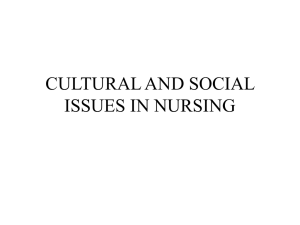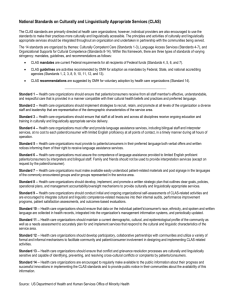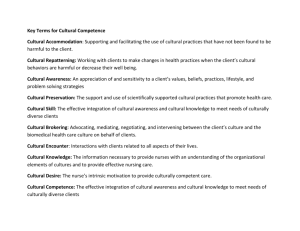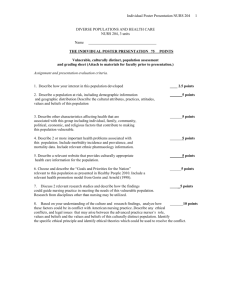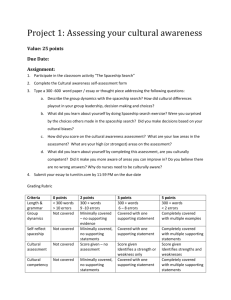CULTURALLY COMPETENT CARE IN THE WORKPLACE
advertisement
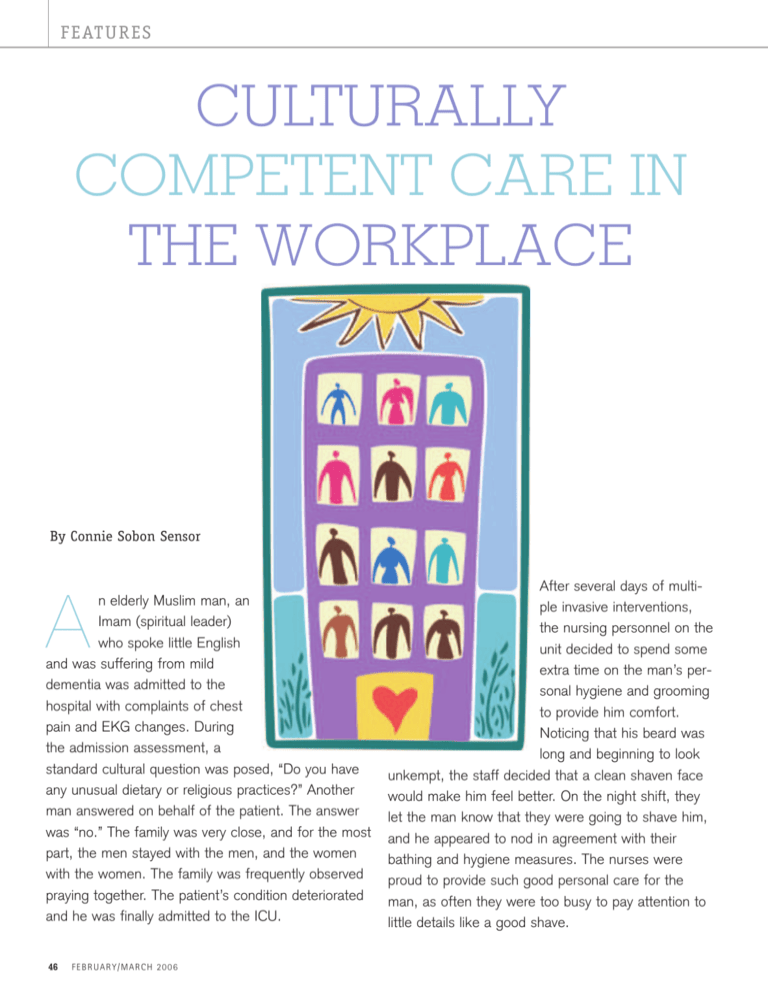
FEAT URE S CULTURALLY COMPETENT CARE IN THE WORKPLACE By Connie Sobon Sensor A n elderly Muslim man, an Imam (spiritual leader) who spoke little English and was suffering from mild dementia was admitted to the hospital with complaints of chest pain and EKG changes. During the admission assessment, a standard cultural question was posed, “Do you have any unusual dietary or religious practices?” Another man answered on behalf of the patient. The answer was “no.” The family was very close, and for the most part, the men stayed with the men, and the women with the women. The family was frequently observed praying together. The patient’s condition deteriorated and he was finally admitted to the ICU. 46 FEBRUARY/MARCH 2006 After several days of multiple invasive interventions, the nursing personnel on the unit decided to spend some extra time on the man’s personal hygiene and grooming to provide him comfort. Noticing that his beard was long and beginning to look unkempt, the staff decided that a clean shaven face would make him feel better. On the night shift, they let the man know that they were going to shave him, and he appeared to nod in agreement with their bathing and hygiene measures. The nurses were proud to provide such good personal care for the man, as often they were too busy to pay attention to little details like a good shave. FE AT U R ES Remember… Ask non-judgmental, open ended questions that begin “Tell me about” or “I would like to learn more about”: What caused your illness? What have you done in the past that helped you get better? What should we do if you get very sick? For example, “Tell me about the marks on your back,” instead of “How did you get the bruises on your back?” Imagine the nurses’ surprise when the family visited and became visibly horrified at the sight of their clean-shaven father in the bed. They rushed from his room and announced that they would be unable to visit their father as their religious beliefs forbade them to gaze upon their father’s unshaven face. As a holy man, his beard had never been shaved. The family began arrangements to travel to the holy land to make a sacrifice for this taboo that had been breached. They believed that their father would be judged as a “non-believer” if he were to die with a clean-shaven face. The man subsequently died alone in the hospital with no family in attendance. The hospital was located in a community with a high percentage of Muslim clients. What happened here? First of all, the family responded that they had no “unusual dietary or religious practices.” Their beliefs and practices were not “unusual” to them. The assessment questions should have been designed to elicit more pertinent information. The staff did not know that the man’s beard was a symbol of his religious faith. The staff was guilty of cultural ignorance of the man’s beliefs and practices, and cultural imposition of their own values regarding the hygienic appearance of a clean-shaven face. The healthcare organization should have been aware of the community beliefs and practices, and should have made it their business to involve key religious leaders in learning about the needs of the community. Upon discovery, the staff should have apologized immediately and used an appropriate intervention such as, “I would like you to tell me more about your religious beliefs and practices so that I can make certain nothing like this ever happens again when we are taking care of a Muslim man.” The court deemed that the hospital staff was responsible for knowing the cultural beliefs and practices of the demographic population in the community that they served. Paul M. Schyve, Joint Commission on Accreditation of Healthcare Organizations (JCAHO) Project Advisor, Hospitals, Language and Culture, advocates “the delivery of health care services in a manner that is respectful and appropriate to an individual’s language and culture is more Patients appreciate the personal interest shown in a cultural assessment. It helps them to relax enough to tell you about everything else they tried before seeking professional health care. than simply a patient’s right, but is, in fact, a key factor in the safety and quality of patient care” (Schyve, Paul 2002). It is obvious from this example of cultural conflict, that indeed, culturally competent care is a key factor in the quality of patient care, and patient satisfaction as well. It is much more than using a common language or an interpreter to communicate vital information. Cultural competence begins with self-awareness of our own values and biases, and is fortified by seeking cultural knowledge from others. The Office of Minority Health defines culturally competent health care as “services that are respectful of and responsive to the health beliefs and practices, and cultural and linguistic needs of diverse populations (OMH, 2001).” It can be further explained as the ability of healthcare providers and organizations to understand and effectively respond to the cultural and linguistic needs brought by clients to the healthcare encounter. In 2001, the U.S. Department of Health and Human Services Office of Minority Health issued fourteen national standards for Culturally and Linguistically Appropriate Services in Health Care (CLAS standards). A national advisory committee of policymakers, providers and researchers developed these fourteen standards to eliminate cultural health disparities and ensure equal access to quality health care by diverse populations. CLAS standards address culturally competent care, language access service, and organizational supports for cultural competence. JCAHO has developed interface criteria with CLAS standards for accreditation of health care facilities. Compliance with CLAS standards is also mandated for funding of federal programs. Organizations that employ nurses will be very interested in compliance with these standards because of the link to accreditation and funding, vital sources of health care dollars. Expect to see culturally aware healthcare workers provide culturally competent care for the demographic populations they serve, as mandated in the CLAS standards and JCAHO regulations. You can expect to have annual competency education in your workplace to prepare you to work with culturally diverse populations. Currently, New Jersey is the first state to mandate specialized training in cultural competence as a component of basic medical education. Find out more about the CLAS standards at www.omhrc.gov/clas and more about JCAHO 2005 Requirements Related to Provision of Culturally and Linguistically Appropriate Health Care at www.jcaho.org, click on Collaborations, then Hospitals, Language and NSNA IMPRINT | www.nsna.org 47 FEAT URE S Culture. (For a list of the 14 CLAS standards, see the information box on page 51). Another way to assure culturally competent health care is by learning more about the practice of transcultural nursing, a specialty focusing on comparative study and analysis of different cultures and subcultures with regard to their caring behavior, nursing care, and health-illness values, beliefs and patterns of behavior. This is an integral component of culturally competent health care. The more you use transcultural nursing assessment, planning and intervention, the more comfortable, confident and skilled you will become at the practice. You can find a transcultural education program, a local chapter, or learn more about the specialty of Transcultural Nursing from the website: www.tcns.org Patients appreciate the personal interest shown in a cultural assessment. It helps them to relax enough to tell you about everything else they tried before seeking professional health care. I always learn something new. Cultural assessment will become a valuable skill as you learn to interview and assess your patients and their families by asking non-judgmental, open ended questions that begin with the words “Tell me 48 FEBRUARY/MARCH 2006 about” or “I would like to learn more about” …what caused your illness? ...what you have done in the past that helped you to get better? …what we should do if you get very sick? Questions like this will tell you about your patient’s health care belief system, the cause of their illness, and what they think is necessary to restore their health. If you do not understand their belief system, you will not be able to heal them with nursing and biomedical science alone. They may need a spiritual leader to pray, a spiritual healer, such as a curandero, to rid them of the evil eye, or a special religious amulet or icon to protect them from evil spirits that cause illness. They may want the window closed or the air conditioning turned off, or to eat only hot food to restore the heat lost by childbirth or illness, thus restoring balance to the body. You must gently inquire about other therapies in use prior to seeking professional health care. Most people use home remedies first, such a chicken soup, herbs, teas, massage, acupuncture or healing rituals. Never refer to marks on the body as bruises, as this implies intentional injury. Ask the patient to “tell me about the marks on your back.” You may be surprised to find that the patient has used the folk healing practice of “coining” or “cupping” to restore health before seeking professional care. FE AT U R ES To be culturally competent, nurses must develop an awareness of causes of cultural conflict: Some Rules for Culturally Competent Communication in Health Care: • Ethnocentrism (the belief that one’s own way of life is better than others); • Minimize the influence of personal, professional and organizational bias. • Bias and prejudice (the mental attitude attributing negative or positive characteristics to others); • Interpret behaviors of others from their own context. • Discrimination (acting on one’s prejudices); • Stereotyping (fixed, unchanging and usually negative attribution about groups of people); • Cultural imposition (forcing one’s own values, beliefs and way of life on others); • Cultural ignorance (lack of knowledge of the culture); • Lack of understanding of the process and pattern of communication in the group; • Use the language and communication patterns of the other. Use formal titles such as Mr., Mrs., or Señor, Señora, etc. to show respect. Often a patient nods out of respect, but does not understand or agree. Pay attention to tone of voice. Clarify communication with a return demonstration from the patient. • Address the group rather than the individual. Most cultures are group oriented. The family makes a decision about the appropriate health care intervention. Ask the patient to identify the family spokesperson. In some cultures, the family protects the sick patient from bad news and worry so that the patient can rest and recover. NSNA IMPRINT | www.nsna.org 49 FEAT URE S • Respect and accommodate differences. Observe nonverbal behavior and match the degree of distance exhibited by the client or family members. Allow clothing or special objects of importance to the client. • Request interpreter to ask client for feedback and clarification at regular intervals; • Work with others’ established social hierarchy. This hierarchy is determined by permanent markers such as age, gender or position. Ask the client to name the person to consult for major decisions and how to contact this person. If they are in another country, be prepared to wait for days or longer to get consent for a procedure or treatment. As healthcare providers, we must be certain that our clients feel respected and cared for. In these Teaching self-care to a patient will send the message of a lazy nurse to cultures where family members usually care for one another. In these situations teaching the family to care for the patient is more acceptable than teaching the sick patient to take care of himself. Some cultures will let you know that you have offended them, but most will use withdrawal and indirect communication, and you will never know what happened. They will talk to others in their group about being misunderstood or disrespected by the health care provider. The others in their group will be reluctant to seek professional health care when they are sick. The patient may never return for follow-up. This limits access to professional health care, and contributes to health disparities in diverse populations. We must work to overcome the barriers to equal and accessible quality health care for all people by providing care that is culturally competent and respectful at all times. ¥ • Become comfortable with silence. Often this is a sign of respect, or indication that the client is thinking about what you said. Be patient in waiting for a response to your questions. If the client needs an interpreter: • Make sure that the interpreter can speak the dialect of the client; • Ensure gender, age and ethnic compatibility of interpreter with clients’ preference and topic to be discussed; • Watch for differences in educational and socioeconomic status between the client and interpreter; • Orient interpreter to your purpose and expectation; • Clarify your questions about the interpreter’s training, compatibility with the client and interpreter understanding of your expectation beforehand; • Introduce the interpreter to the client; • Pace your speech slowly and allow time for back translation; • Direct your questions to the client; 50 FEBRUARY/MARCH 2006 • Observe client’s non-verbal and verbal behavior. references U.S. Department of Health and Human Services Office of Minority Health. (2001). National Standards for Culturally and Linguistically Appropriate Services in Health Care. Rockville, MD: IQ Solutions, Inc. Retrieved from http://www.omhrc.gov/ omh/programs/2pgprograms/ executive.pdf on November 30, 2005. Schyve, Paul. (2002). Hospitals, Language, and Culture Project. Joint Commission on Accreditation of Healthcare Organizations. Retrieved from www.jcaho.org/about+us/hlc/index.htm tp://www.jcaho.org/ about+us/hlc/index.htm> Connie Sobon Sensor, MSN, CCRN, CTN, is adjunct Professor of Nursing at Kean University, Union, NJ where she teaches Transcultural Health Care. She studied with Dr. Madeline Leininger, the founder of Transcultural Nursing and is currently the President of the Mid-Atlantic Chapter of the Transcultural Nursing Society.
